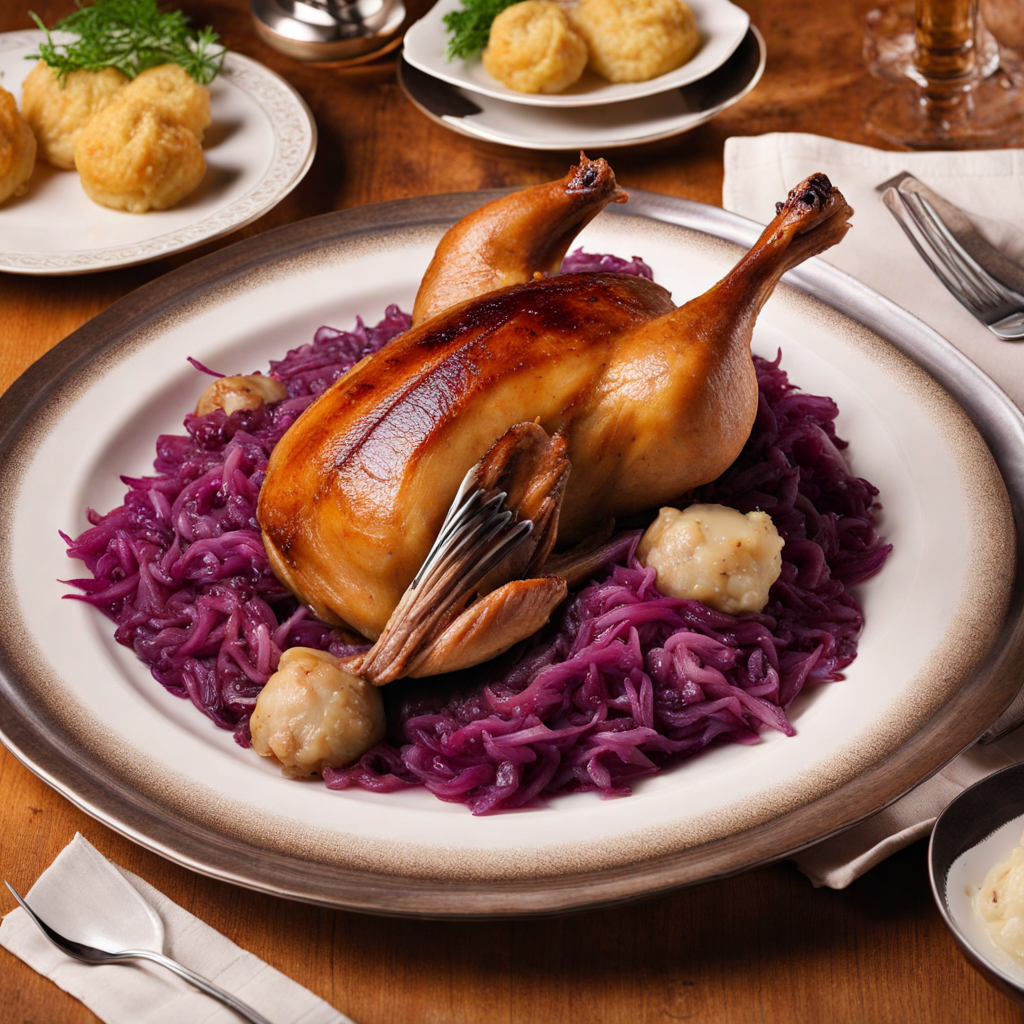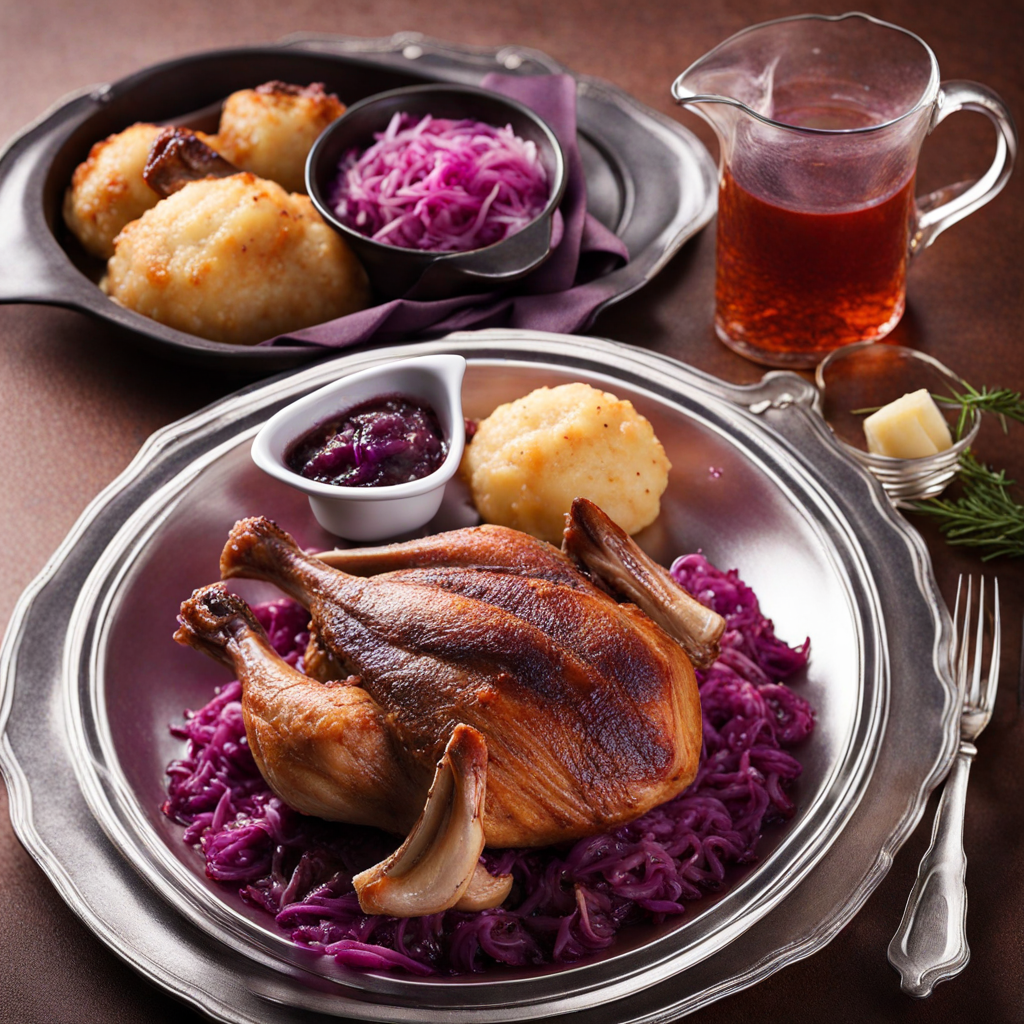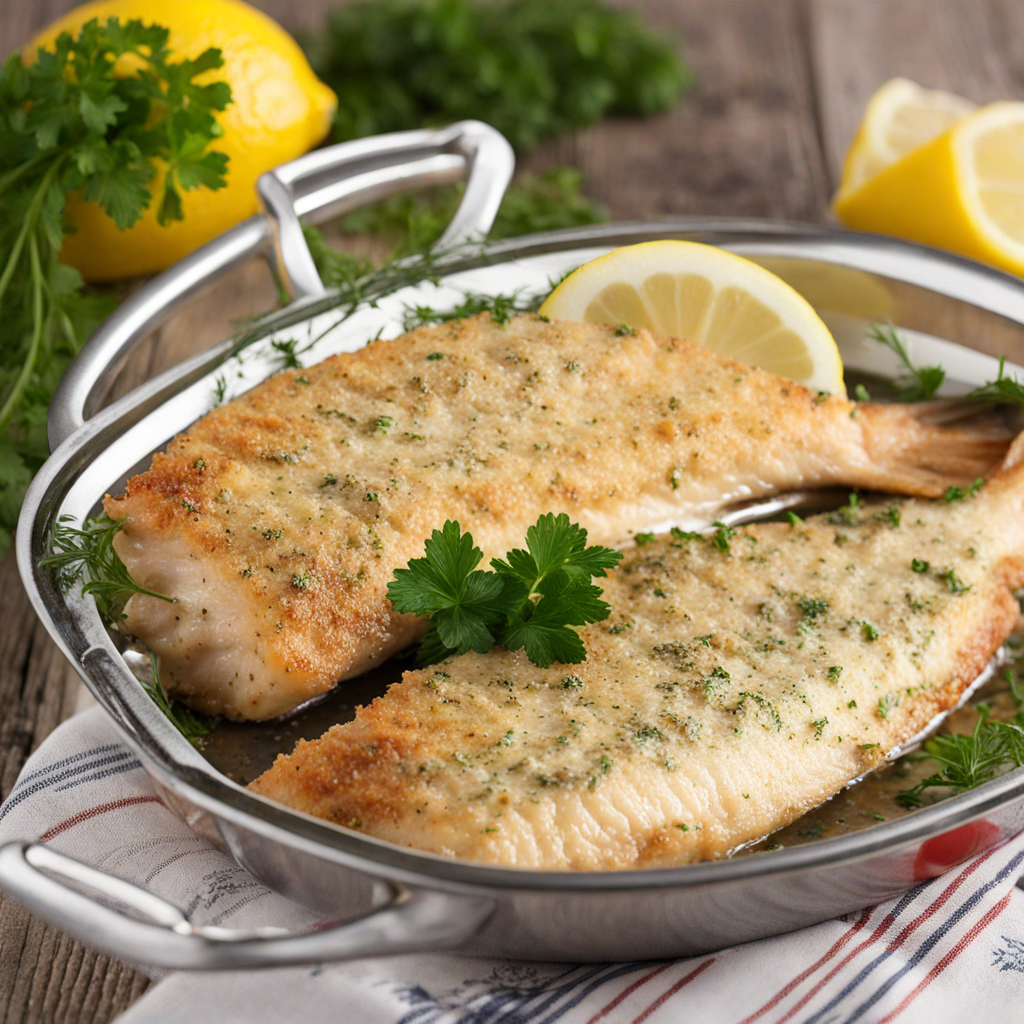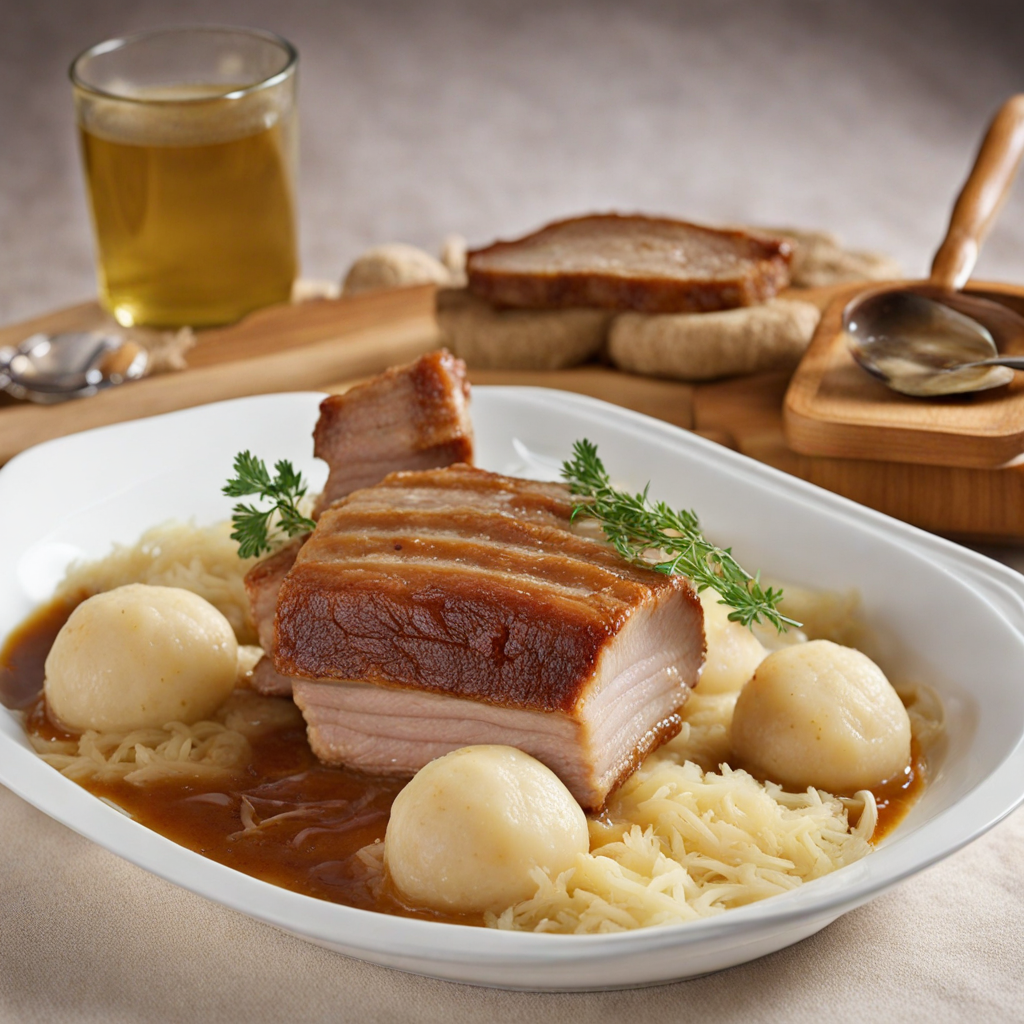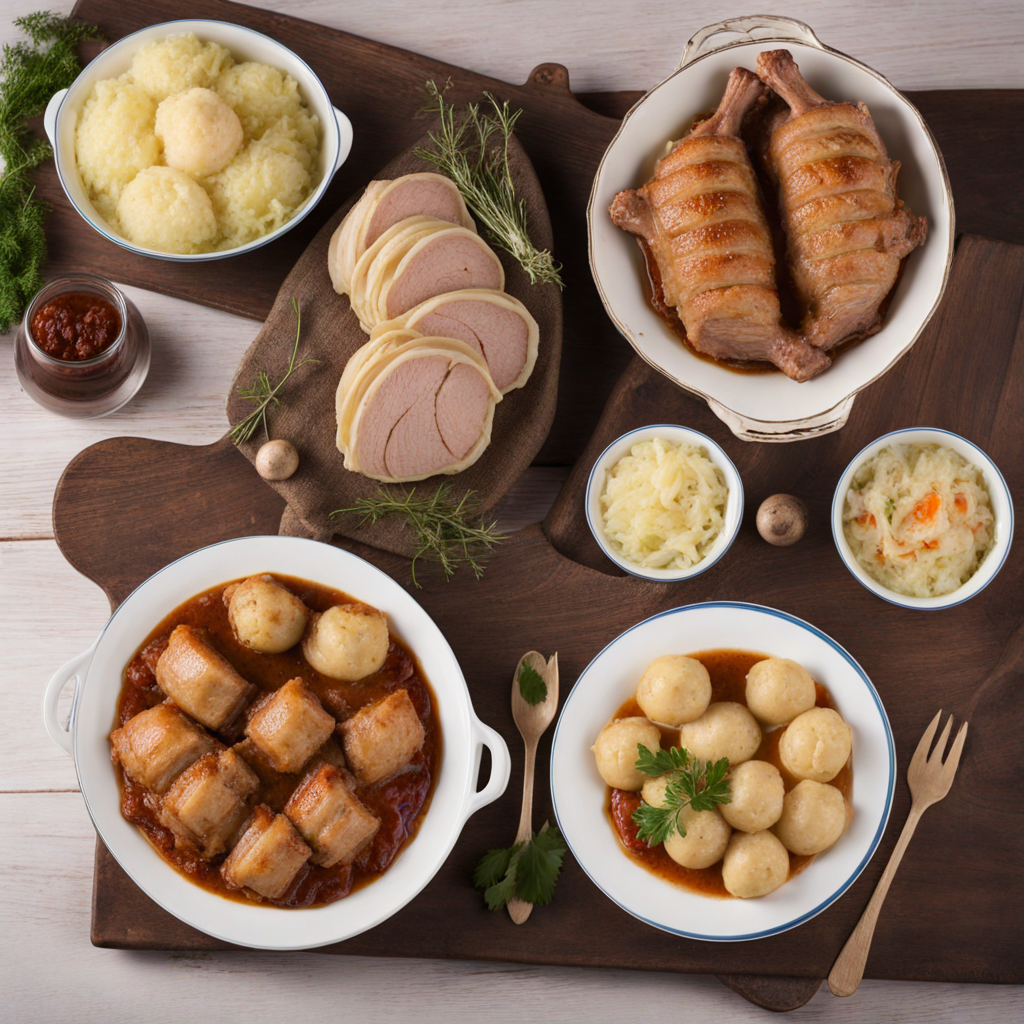Roast Duck with Red Cabbage
Roast Duck with Red Cabbage is a traditional Czech dish that showcases the rich flavors and hearty ingredients characteristic of Central European cuisine. The star of the dish, the roast duck, is typically seasoned with a blend of herbs and spices, allowing the meat to develop a beautifully crisp skin while remaining tender and juicy on the inside. The slow-roasting process helps to render the fat, which imbues the meat with a deep, savory flavor that is both satisfying and indulgent. The duck is often served with a side of golden-brown dumplings, which are perfect for soaking up the delicious juices from the meat. The accompanying red cabbage adds a vibrant pop of color and a sweet-tart contrast to the richness of the duck. Traditionally, the cabbage is braised with apples, vinegar, and a hint of sugar, creating a delightful balance of flavors. The cooking process softens the cabbage while infusing it with a warm, comforting aroma, making it a perfect complement to the savory duck. Each bite offers a harmonious blend of textures and tastes, from the crunchy cabbage to the succulent meat. This dish is not only a feast for the palate but also for the eyes, with its striking presentation. The deep red of the cabbage against the golden-brown duck creates an inviting plate that reflects the heartiness of Czech culinary traditions. Enjoyed during festive occasions and family gatherings, Roast Duck with Red Cabbage is more than just a meal; it is a celebration of flavor, culture, and the joy of sharing food with loved ones.
How It Became This Dish
Pečená kachna se zelím: A Culinary Journey Through Czech History Pečená kachna se zelím, or roasted duck with sauerkraut, is a quintessential dish in Czech cuisine that encapsulates the rich culinary heritage of the Czech Republic. This dish, characterized by its succulent roasted duck served alongside tangy sauerkraut, not only represents the flavors of the region but also serves as a testament to the historical and cultural evolution of Czech society. Origins of the Dish The roots of Pečená kachna se zelím can be traced back to the Middle Ages when duck was a favored poultry choice across Europe, especially in Central and Eastern European countries. The Czech lands, influenced by various cultural exchanges owing to their central geographic location, saw the integration of numerous culinary practices. Ducks were domesticated and began to populate the waters of the region, making them both a practical and flavorful choice for local diets. Sauerkraut, or "zelí," has a rich history that spans centuries and is believed to have originated in ancient China, before making its way to Europe via the Mongol invasions. By the 16th century, sauerkraut was widely consumed in the Czech lands, a staple that not only provided essential nutrients during the harsh winters but also showcased the region's penchant for preserving food. The fermentation process allowed communities to make the most out of seasonal vegetables, contributing to the sustainability of local diets. Cultural Significance Pečená kachna se zelím is more than just a meal; it is a cultural icon in the Czech Republic. Traditionally served during festive occasions and family gatherings, this dish embodies the spirit of Czech hospitality. Its inclusion in celebrations, such as Christmas or Easter, reflects the importance of communal meals in Czech culture, where food acts as a medium for social bonding. The dish also highlights the relationship between the Czech people and their land. The use of locally-sourced ingredients, such as duck raised in the rich wetlands of Bohemia and the cabbage that thrives in the Czech climate, illustrates a deep-seated connection to the agricultural practices of the region. This connection is further emphasized in traditional Czech folklore, where food is often intertwined with seasonal rituals and celebrations. Evolution Over Time As the Czech Republic underwent various political and social changes, so too did its culinary landscape. The Habsburg influence in the 18th century introduced new flavors and cooking techniques, leading to the refinement of many traditional dishes, including Pečená kachna se zelím. The integration of spices and ingredients from the imperial court elevated the dish, making it a symbol of both local pride and aristocratic elegance. The industrialization of the 19th century brought significant changes to food production and consumption patterns. As urbanization increased, many traditional dishes adapted to suit the needs of a growing working class. Pečená kachna se zelím became a staple in taverns and restaurants, where it was prepared in large quantities, making it accessible to a broader audience. This period also saw the introduction of side dishes, such as knedlíky (dumplings), which complemented the dish and became an integral part of the Czech dining experience. The post-World War II era marked a significant turning point for Czech cuisine, as the country fell under communist rule. Traditional recipes were often simplified, and the focus shifted toward mass production and availability of food. Despite these changes, Pečená kachna se zelím remained a beloved dish, representing a sense of nostalgia for the pre-war culinary traditions. Many families kept their recipes alive, passing them down through generations, ensuring that the essence of this dish was preserved amid the evolving food landscape. Contemporary Relevance In recent years, there has been a resurgence of interest in traditional Czech cuisine, driven by a growing movement toward local and sustainable food practices. Chefs and home cooks alike are revisiting classic recipes, infusing them with modern techniques while honoring their historical roots. Restaurants across the Czech Republic now showcase Pečená kachna se zelím on their menus, often presenting it with a contemporary twist, such as pairing it with craft beers from local breweries or serving it alongside artisanal bread. The dish has also found its place in the international culinary scene, as Czech cuisine gains recognition beyond its borders. Food festivals and cultural events have celebrated Pečená kachna se zelím, allowing a new generation to experience its rich flavors and heritage. Additionally, the dish's adaptability has led to variations and reinterpretations, catering to diverse dietary preferences, including vegetarian options that maintain the spirit of the original. Conclusion Pečená kachna se zelím stands as a remarkable testament to the Czech Republic's culinary heritage, encapsulating centuries of history, cultural significance, and evolution. From its humble origins as a staple in peasant households to its current status as a celebrated dish in restaurants, this meal reflects the resilience and adaptability of Czech cuisine. As the Czech Republic continues to navigate the complexities of modernity while honoring its traditions, Pečená kachna se zelím remains a symbol of national identity—a dish that not only nourishes the body but also feeds the soul, reminding us of the rich tapestry of history, community, and culture that defines the Czech experience. Whether enjoyed in a rustic tavern in Prague or at a family gathering in a small village, this dish will continue to bring people together, one delectable bite at a time.
You may like
Discover local flavors from Czech Republic


